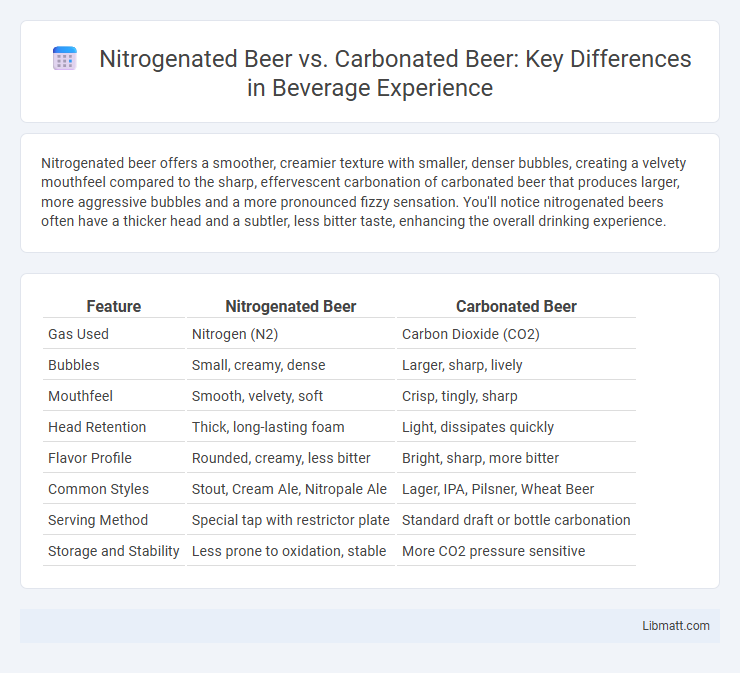Nitrogenated beer offers a smoother, creamier texture with smaller, denser bubbles, creating a velvety mouthfeel compared to the sharp, effervescent carbonation of carbonated beer that produces larger, more aggressive bubbles and a more pronounced fizzy sensation. You'll notice nitrogenated beers often have a thicker head and a subtler, less bitter taste, enhancing the overall drinking experience.
Table of Comparison
| Feature | Nitrogenated Beer | Carbonated Beer |
|---|---|---|
| Gas Used | Nitrogen (N2) | Carbon Dioxide (CO2) |
| Bubbles | Small, creamy, dense | Larger, sharp, lively |
| Mouthfeel | Smooth, velvety, soft | Crisp, tingly, sharp |
| Head Retention | Thick, long-lasting foam | Light, dissipates quickly |
| Flavor Profile | Rounded, creamy, less bitter | Bright, sharp, more bitter |
| Common Styles | Stout, Cream Ale, Nitropale Ale | Lager, IPA, Pilsner, Wheat Beer |
| Serving Method | Special tap with restrictor plate | Standard draft or bottle carbonation |
| Storage and Stability | Less prone to oxidation, stable | More CO2 pressure sensitive |
Introduction to Nitrogenated and Carbonated Beer
Nitrogenated beer is infused with nitrogen gas, creating smaller bubbles that result in a smoother, creamier mouthfeel and a dense, velvety head, commonly found in stouts like Guinness. Carbonated beer uses carbon dioxide, producing larger bubbles that give a crisp, effervescent texture and a sharper taste profile typical in lagers and ales. The difference in gas composition significantly affects the beer's texture, aroma, and visual appeal, shaping distinct drinking experiences.
Key Differences: Nitrogen vs. Carbon Dioxide
Nitrogenated beer uses nitrogen gas, producing smaller bubbles that create a smoother, creamier mouthfeel compared to carbonated beer, which relies on carbon dioxide for larger, more effervescent bubbles. Nitrogen gas has lower solubility in liquid, resulting in a denser, longer-lasting head, while carbon dioxide dissolves more readily, giving a sharper, tangier taste and more pronounced fizziness. The difference in gas solubility and bubble size significantly impacts texture, flavor perception, and overall drinking experience.
The Science Behind Beer Bubbles
Nitrogenated beer uses nitrogen gas, which produces smaller, denser bubbles compared to the larger carbon dioxide bubbles in carbonated beer, resulting in a smoother and creamier mouthfeel. The science behind beer bubbles reveals that nitrogen's lower solubility creates a cascading effect when poured, enhancing texture and visual appeal. Your experience with nitrogenated beer is marked by a softer, less fizzy sensation, contrasting with the sharper effervescence typical of carbonated brews.
Mouthfeel and Texture Comparison
Nitrogenated beer offers a smooth, creamy mouthfeel characterized by tiny, dense bubbles that create a velvety texture. Carbonated beer features larger, more active bubbles resulting in a crisp, effervescent sensation on your palate. This distinct texture difference makes nitrogenated beers feel richer and less sharp compared to the lively carbonation of traditional brews.
Flavor Impact: Nitrogenated vs. Carbonated
Nitrogenated beer delivers a smoother, creamier mouthfeel compared to carbonated beer, thanks to the finer nitrogen bubbles that create a velvety texture and mellow bitterness. Carbonated beer, with its larger carbon dioxide bubbles, provides a sharper, more effervescent sensation that enhances hop aromas and flavor brightness. When choosing your beer, nitrogenation transforms flavor perception by softening acidity and bitterness, while carbonation emphasizes crispness and bite.
Popular Styles for Each Type
Nitrogenated beers are commonly found in popular styles like stouts and porters, where the creamy mouthfeel and smooth texture enhance rich flavors. Carbonated beers dominate a broader range of styles, including lagers, IPAs, and pilsners, where higher carbonation emphasizes crispness and hop aroma. Each carbonation method affects taste perception, making nitrogenation ideal for darker, malt-forward beers and carbonation preferred for lighter, hop-driven styles.
Pouring Techniques and Presentation
Nitrogenated beer requires a specialized pouring technique, often involving a stout faucet or widget that releases nitrogen gas to create a creamy, dense head and smooth mouthfeel, enhancing visual appeal with cascading bubbles. Carbonated beer is typically poured at a steeper angle to maintain carbonation and produce a crisp, foamy head with larger bubbles, emphasizing clarity and effervescence. Proper pouring and presentation are crucial for each type to highlight their distinct textures and enhance sensory experience.
Equipment and Serving Methods
Nitrogenated beer requires specialized equipment such as a nitrogen gas tank and a stout faucet to create its characteristic smooth and creamy texture, while carbonated beer utilizes standard CO2 tanks and typical draft faucets for a crisp and fizzy pour. Serving nitrogenated beer often involves a distinct two-part pour to activate the nitrogen bubbles, enhancing the rich mouthfeel and dense head, whereas carbonated beer is served with a steady pour that maintains its carbonation level. Your choice between these beers influences the type of dispensing system and serving technique necessary to deliver the optimal drinking experience.
Consumer Preferences and Trends
Nitrogenated beer offers a creamier texture and smoother mouthfeel, attracting consumers who prefer a softer, less fizzy drinking experience compared to the sharper carbonation in traditional carbonated beer. Trends indicate a growing interest in craft breweries that experiment with nitrogenation to create unique beer styles, appealing to niche markets seeking innovation in flavor and presentation. Consumer preferences are shifting toward these diverse sensory profiles, driving increased demand for nitrogenated options in both pubs and retail environments.
Which One Should You Choose?
Nitrogenated beer offers a smoother, creamier texture with smaller, finer bubbles, enhancing mouthfeel and flavor, while carbonated beer provides sharper, more aggressive carbonation that highlights hops and malt profiles. Choosing nitrogenated beer suits those seeking a soft, velvety drinking experience often found in stouts and porters, whereas carbonated beer is ideal for lighter styles like lagers and IPAs that emphasize crispness and lively effervescence. Personal preference and beer style guide the choice between nitrogenated and carbonated beers for optimal taste enjoyment.
Nitrogenated beer vs carbonated beer Infographic

 libmatt.com
libmatt.com